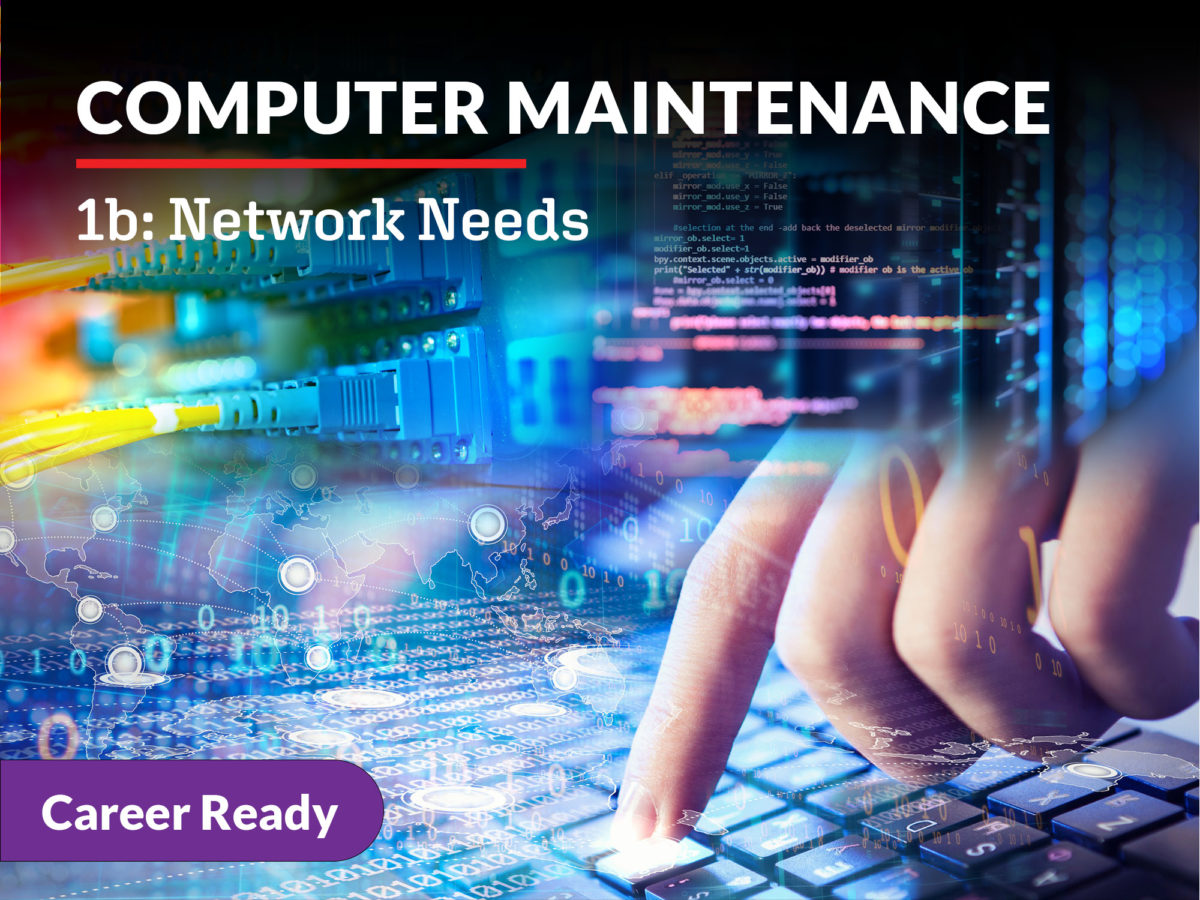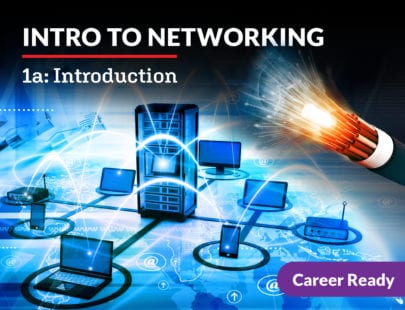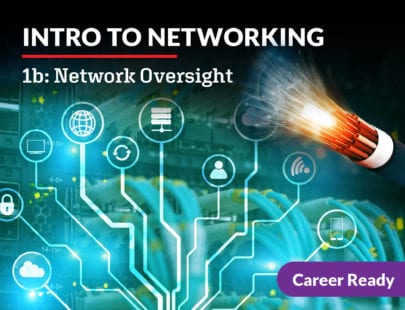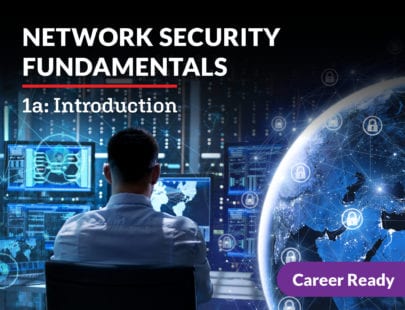
Computer Maintenance 1b: Network Needs
Almost anywhere we go today, from malls to coffee shops, and even our homes is an intertwined web of wired, wireless, and cloud-based networks that access our personal data. In this course, you’ll dig into computer networks and their extensive capabilities. You’ll explore data exposure and how to mitigate threats, discuss the fundamentals of network design and layout, learn how cloud-based services store data, discover the differences between wired and wireless networks, and dream of possibilities as you explore fun network options like smart home systems. Let’s continue navigating the complex world of computer maintenance.
Units at a Glance
Unit 1: Mobile Devices and Laptops
Mobility—it’s really our way of life! Our culture has gotten used to transporting laptops around with us; but as technology keeps advancing, most of us can now carry a very powerful computer in our pocket: the smartphone. While some people use their phones as a computer, others prefer to only use a few apps and see it as, well, a phone! Let’s look at how laptops and mobile devices function and how we can solve any issues we may run into when using them.
What will you learn in this unit?
- Explain the differences between laptops and desktops
- Explore the characteristics of mobile devices
- Discuss how to connect and sync mobile devices
- Consider emerging mobile technologies
- Troubleshoot problems with laptops and mobile devices
Unit 2: Network Fundamentals
Take a look at your calendar or planner. Chances are, you have your time divided into different blocks—school, work, community events, sports practice, meals. As we go about our daily lives, weaving in and out of our homes, schools, stores, or restaurants, we’re constantly entering and exiting invisible territories: networks! Networks have become a part of our daily lives, even if we don’t realize it. Because we now live in a digitally connected world, knowing some basics about networks is crucial—not only so we can communicate efficiently but also so we can make choices that keep our data safe too.
What will you learn in this unit?
- Identify network topologies
- List the layers of the OSI model and describe their function in allowing data to flow through networks
- Define ports and protocols
- Consider how Windows networks function
Unit 3: All About Servers
When you input a search request into Google, a web server responds and provides the search results. When you log in anywhere, you enter your username and password, and a server authenticates your credentials—this means that it matches the username to the password. If it matches, access is granted; if it doesn’t, access is denied. When you access the internet, your internet service provider (ISP) has a server that authenticates the IP address of your computer to allow access. What’s the common denominator here? Servers! Let’s explore what servers are (hint: they are real, tangible things!), what they help us do, and how they work.
What will you learn in this unit?
- Describe the function of web and mail servers
- Explain what file and print servers do
- Discuss how DHCP and DNS servers work
- Consider how authentication and proxy servers function
- Provide administration and troubleshooting for servers on a network
Unit 4: Network Hardware Devices
Networks are all around us: at home, work, school, the library, or the gym. And by now, we know a lot about how networks are designed and how the computers within networks function. But what is behind the walls, in the ceilings, and under the floors that connect the devices and make the network work? It’s time to learn about all of the devices that make these networks possible!
What will you learn in this unit?
- Describe how a modem and router work
- Explain the difference between a hub and a switch
- Extend the reach of your wireless signal
- Consider what other network devices you need in your network
- Troubleshoot common issues with network hardware devices
Unit 5: Cloud Computing
It seems that no matter what decade, whenever we envision the future, we think of flying cars. We’re still not there, but cloud computing has brought us to the horizon of modern data storage trends. Cloud computing has transformed industries like IT and education, but it has also changed the way we access data personally. In the cloud, we have infinite scalability and flexibility, so companies can grow more easily because they don’t have to build a huge new server room each time they expand. You’re probably familiar with some of the well-known cloud providers like Amazon Web Services, Google Cloud, IBM Cloud, and Microsoft Azure, but let’s learn about what goes on behind the scenes to give us remote access to data and services at lightning speed.
What will you learn in this unit?
- Describe the cloud and cloud computing
- Define various ways to store data in the cloud
- Analyze cloud computing models and providers
- Consider the purpose and use of virtual machines
Unit 6: Wired Networks
These days, it seems like everything is wireless, right? But, there are still advantages to using a wired network. Wired networks have dedicated bandwidths and fewer network traffic interruptions, so data arrives at its destination in a timely manner. They also have less interference from other devices, so they suffer fewer outages. That’s all important, but wired networks can also be fun! Want your fridge to tell you when you’re out of milk? It’s possible with wired networks. Let’s think deeper about the wired networks we rely on at home to see how they really work behind the scenes and start thinking about how we can incorporate wired devices into our dream smart home.
What will you learn in this unit?
- Explain how to configure a router
- Describe what quality of service (QoS) is
- Configure network interface cards, switches, and modems
- Discuss the basic components of smart homes
- Troubleshoot issues with wired networks
Unit 7: Wireless Networks
Chances are, you are more or less the tech expert in your household. You can help people set up computer equipment and troubleshoot issues that would frustrate most users. In a SOHO environment, we rely on our devices and wireless connectivity for just about everything we do. Knowing what these pieces of equipment are, what they do, and how they work is essential to keeping everyone in the home happy. After all, what’s life if you access the internet?
What will you learn in this unit?
- Explain how to configure various wireless devices
- Describe wireless protocols
- Choose from popular smart devices
- Explain how to secure and troubleshoot wireless networks and smart devices
Unit 8: Advanced Security Concerns
Identity theft is a multi-billion dollar business with most identity thieves going unpunished. How can we keep our personal data and that of our company safe in digital times? Security is an important aspect of being a responsible digital citizen. Some tactics we’re pretty familiar with already, but there are still quite a few more advanced security concepts that we’re in a prime position to handle now. You’ve designed networks, built computers, dreamed up an awesome smart home, and now it’s time to protect it all!
What will you learn in this unit?
- Identify different types of malware
- Discuss other major security threats like social engineering
- Implement physical security and prevention measures
- Understand how data is protected on mobile devices
- Protect our workstations from security threats
- Explain how Windows Active Directory works
- Use RADIUS or TACACS to authenticate users on a network
Required Materials
Software
- Word processing software
- Presentation software
- Spreadsheet software
Optional
- Graphic design software
- Pen and paper
- Digital camera





